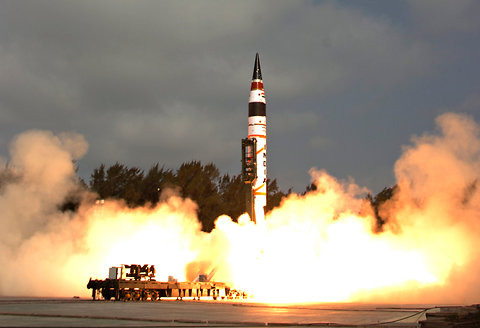AGNI. The Hindu word for “fire.” The 14-ton, two-stage Agni missile, with an estimated range of 1,000 to 1,500 miles, was test-fired over the Bay of Bengal from a launch site 750 miles southeast of Delhi in May 1989. A second generation, designated as the Agni-Plus and Agni-B MRBM, went into development in December 1996, together with a submarine-launched variant, the Sagarika.
INDIAN NUCLEAR WEAPONS PROGRAM
In 1964, Indian Prime Minister Lal Bahadur Shastri promoted research and development into what was called a “Subterranean Nuclear Explosion for Peaceful Purposes.” India detonated its first atomic device ten years later, on May 18, 1974, using fissile material derived from a Canada Deuterium Uranium (CANDU) reactor. Although India had previously claimed its atomic forays were solely for peaceful nuclear purposes, in May 1998—after testing five nuclear devices—India formally declared itself a nuclear weapons state. India is not a member of the Nuclear Nonproliferation Treaty (NPT) of 1968, however, and refuses to join, claiming that the NPT is a discriminatory regime. According to the Wisconsin Project’s Risk Report (2003), India may possess sufficient fissile material to produce up to 100 nuclear warheads.
In establishing its nuclear command and control organization, India promulgated its own nuclear doctrine in 1999, claiming its policy was “no first use” and that its nuclear forces were intended to provide only a “credible minimum deterrent.” The Indian government also claims that it has nuclear devices possessing the capability of low yields to 200 kilotons involving fission, boosted-fission, and two-stage thermonuclear designs (see Fission Weapons; Thermonuclear Bomb). India is reportedly pursuing a triad of nuclear forces to include air-, land-, and sea-based delivery platforms (for example, submarines). As of 2004, India’s primary means of delivering nuclear warheads included ballistic missiles such as the Privthi I short-range ballistic missile (SRBM) and the medium-range Agni II. For aircraft delivery, India would most likely use modified versions of the MiG-27 Flogger and the Jaguar IS/IB. Intense enmity and occasional wars with Pakistan— as well as ongoing conflict in the disputed Kashmir region—have led to even more heightened tensions in the twenty-first century because the two South Asian nations both possess nuclear weapons.
Estimates of how many warheads India possesses range from 30 to 150. At the end of 1999, India was believed to possess 240–395 kilograms of weapons-grade plutonium, which could be used to build 45–95 nuclear warheads. The amount of plutonium that could be extracted from India’s six heavy-water nuclear power plants could be used to build as many as 200 nuclear devices.
In August 1999, the Indian government released a draft nuclear doctrine prepared by the nonofficial National Security Advisory Board. The Indian government continues to develop its nuclear doctrine and has stated that no-first-use of nuclear weapons and civilian control over nuclear weapons are key to their effort to develop a credible minimal deterrent based only on retaliation. Indian officials also assert that global, verifiable, and non-discriminatory nuclear disarmament remains as a “national security objective.”
The Indian government announced the establishment of the Nuclear Command Authority (NCA), which will manage and administer all of India’s nuclear and strategic forces, in January 2003. The NCA includes the civilian Political Council, headed by the prime minister, which will have sole authority over the release of nuclear weapons.
In May 1998, India announced a voluntary moratorium on further nuclear testing, excluding computer simulation and subcritical tests. India is developing several ballistic missile systems, particularly the Agni I with a tested range of 800 kilometers, Agni II with a demonstrated range of more than 2,000 kilometers, and the Agni III with a planned range of up to 3,500 kilometers. India and Russia are jointly developing a supersonic cruise missile, the Brahmos, with a range of 280 kilometers. The Brahmos entered production in 2004. India also is working on at least two naval systems that may be equipped to carry nuclear warheads.
References “India Nuclear Weapon Update 2003,” The Risk Report, vol. 9, no. 5, September-October 2003. “India Profile,” Nuclear Threat Initiative, 2003, available at http://www.nti.org. National Security Council (India), National Security Advisory Board, “Draft Report of National Security Advisory Board on Indian Nuclear Doctrine,” 17 August 1999, available at http://www. indianembassy.org/policy/CTBT/nuclear_doctrine_ aug_17_1999.html. “WMD around the World: India Special Weapons Guide,” available at http://www.fas.org/nuke/guide/ india/index.html.
Strategic Forces Command – 2010
India’s Nuclear Command Authority (NCA) controls the nation’s nuclear weapons. The NCA comprises a Political Council and an Executive Council. The Political Council, chaired by the Prime Minister, is the only body that can authorise nuclear weapons use; the Executive Council, chaired by the National Security Advisor to the Prime Minister, provides inputs for decision making by the NCA and executes directives given by the Political Council. Strategic Forces Command (SFC) is a tri-service command established in 2003. The Commander-in-Chief of SFC, a senior three-star military officer, manages and administers all Strategic Forces through separate Army and Air Force chains of command, with the army responsible for all nuclear-capable land-based ballistic missiles and the air force responsible for all nuclear-capable fixed-wing aircraft (the navy is not yet nuclear-capable). The navy is also establishing its own chain of command, following the launch of INS Arihant in July 2009. The C-in-C SFC reports directly to the Chairman, Chiefs of Staff Committee.
FORCES BY ROLE
Missile 2 Groups with SS-150/SS-250 Prithvi
1 Group with Agni I
1 Group with Agni-II
EQUIPMENT BY TYPE
MISSILE STRATEGIC
IRBM 80–100 Agni I; 20–25 Agni-II; Agni-III (successfully tested)
SRBM 60 missiles produced 1993–1999. Up to 20 SS-150 Prithvi I/SS-250 Prithvi II missiles produced each year; SS-350 Dhanush (naval testbed)
Some Indian Air Force assets (such as Mirage 2000H or Su-30MKI) could be tasked with a strategic role
Vishwakarma, Arun (2007-07-01). “Indian Long Range Strategic Missiles” (PDF)
